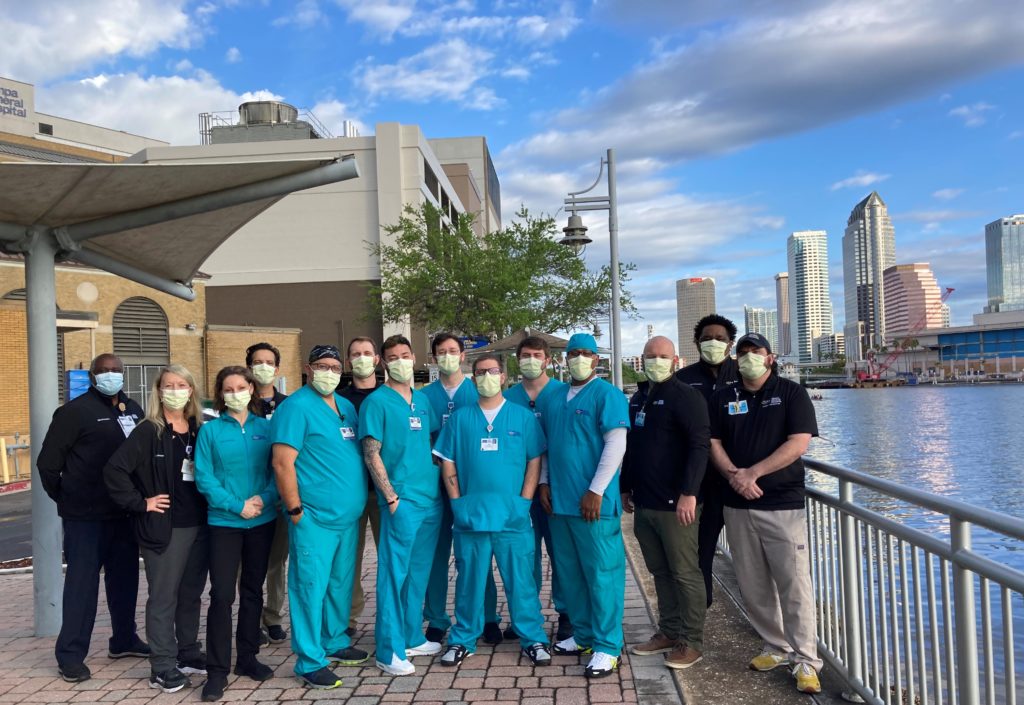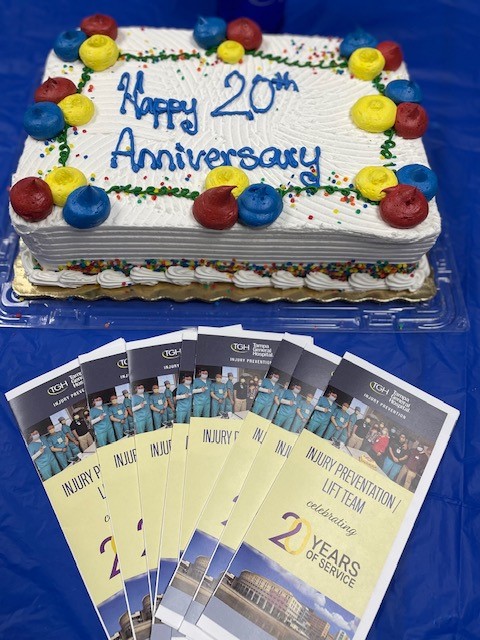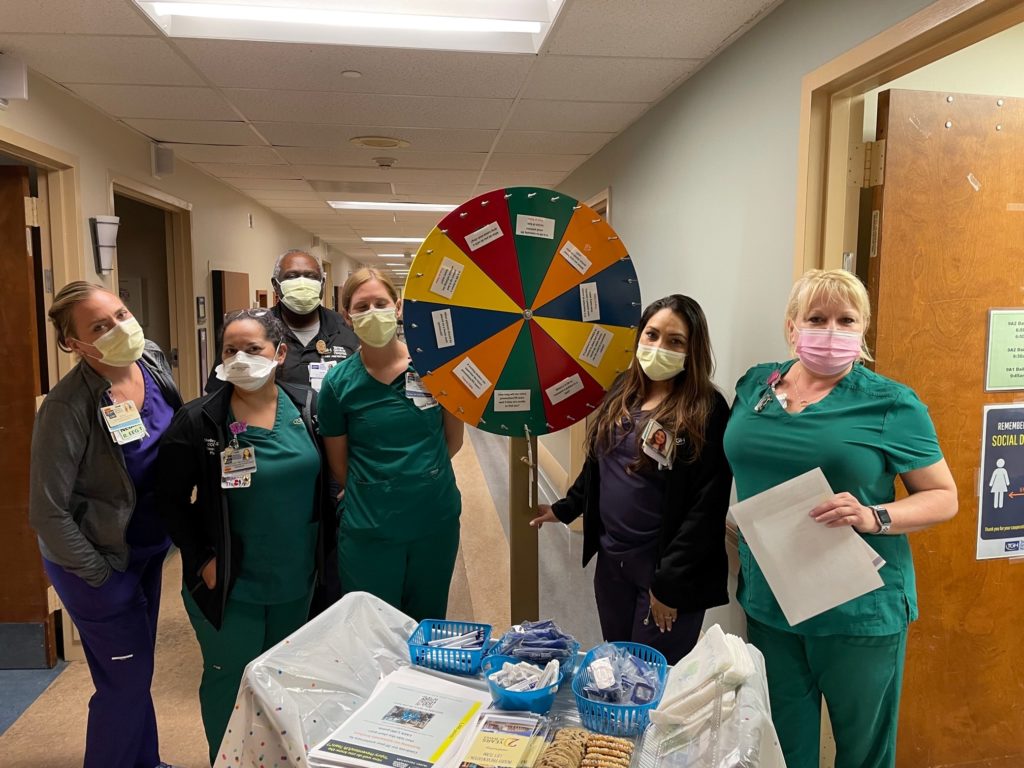TGH 20th anniversary of Lift team program
Written by Manon Labreche and the Tampa General Lift Team.
Why the need for a Lift Team?
20 years ago, Tampa General Hospital (TGH) a 1,000-bed level 1 trauma center in Tampa, Florida recognized the need to protect their nurses from injuries related to moving and handling patients. At the time, there was a significant nursing shortage, and the bariatric population was increasing in the USA, therefore the hospital felt it was time to devise a plan to increase safety. At the time, there was limited patient lift equipment available and no safe patient handling program. Team members were mostly manually lifting patients, injuries were high and TGH was losing a lot of experienced nurses from back injuries. This was not only costly to the organization, but TGH was losing a wealth of knowledge and expertise when a nurse was injured, not to mention how manually lifting patients negatively impacts patient outcome and satisfaction.
Growth of the Lift Team.
This is when the lift team program was initiated in 2002, where 6 people were hired to “lift patients” in/out of bed. A few floor-based lifts were purchased as well as friction-reducing devices on all units. The organization made a commitment to continue to purchase patient lift equipment each year and has held true to their word. In 2002, the lift team performed approximately 20 lifts per day and were available from 9am-7pm, 5 days per week.
Now fast forward 20 years, the lift team has expanded from 6 team members to approximately 25 and their roles have also expanded as well as their level of knowledge and expertise. The team also changed their names to “injury prevention team” to better represent their job duties. They utilize patient lift equipment on > 90% of their calls, they now perform approximately 125-150 transfers or repositioning each day and are available 24 hours/day, 7 days/week.

What does the lift team do?
Their job duties now include moving the most complex patients in/out of bed including patients using ECMO, patients who have severe burns, COVID 19 patients etc., and they assist in the 12 ICU units by rounding every 2 hours to assist with linen changes and repositioning. Other duties include: assisting with fall recovery transfers, vehicle transfers upon admission or discharge, assisting EMT/paramedics in the emergency room with bariatric admissions and discharges, and assisting in the morgue with funeral home discharges and autopsy transfers. They also assist various teams and physicians such as the radiology team, procedural areas, transport team, wound care, therapy, and they play an instrumental role with caring and moving the bariatric population.
They are truly the safe patient handling experts mobilizing patients all day utilizing patient lift equipment. They have a high level of knowledge and expertise and can critically think and resolve any complex case to minimize manual lifting by being innovative and creative with equipment. They are also instrumental with the maintenance and inventory of all patient lift equipment hospital wide. You can often see them restocking slings, air-assisted matts, charging batteries, and collaborating with our clinical engineer department when a piece of equipment is not functioning correctly. They help to overcome all the typical barriers to utilizing equipment. They make sure the equipment is available, accessible and in good working condition on all units.
The hospital has invested millions of dollars on patient lift equipment. They recognized that having the equipment at the point of care maximized compliance as well reduced the need for storage. TGH has over 600 beds with a ceiling lift track and all newly built rooms are planned with a full room ceiling lift system. The manager of this team collaborated with the design team and architects for all newly constructed units.
Each patient care department also has a floor-based lift to assist with fall recovery, motorized and non-motorized standing aides as well as friction reduction and air-assisted technology. All new team members attend a training in the skills lab upon hire to receive hands-on training on the equipment. The team is available to coach team members at the bedside for the simpler patient handling tasks to maximize use of patient lift equipment to increase team member confidence when using the equipment.
Since the inception of this program 20 years ago, there has been a 71% reduction of patient handling injuries, 82% reduction in back injuries as well as > 90% reduction of cost related to safe patient handling injuries.
Benefits of the Lift Team.
Not only does having equipment and a specialist team help to protect the front-line staff from injuries, it also helps with patient outcomes and satisfaction. Complex patients get out of bed more frequently, utilizing the equipment helps to reduce falls, rounding in the ICU units every 2 hours assists with pressure ulcer prevention, and this team follows the patients throughout their length of stay from the emergency room, ICU, medical/surgical units to rehabilitation, thereby helping to assure continuity of care as it relates to safe patient handling. Having a specialized team who have a high level of expertise with the equipment increases patient satisfaction as they are moved with greater ease thereby reducing their pain and anxiety.
Having a specialized team such as the lift team is much more time efficient for the nurses, as rather than pulling multiple team members away from their patients to help, they can call the injury prevention team and therefore allows the other nurses to remain at the bedside with their patients. Having this team has helped to recruit and retain healthcare workers, and many feel they will never leave TGH as this team is such an asset to their everyday job duties and they can leave at the end of the day with no back discomfort.
Celebrating 20 years!
March 2022 marked their 20-year anniversary where the team celebrated in various ways.

The hospital recognized them by having a large banner posted at the front entrance, a brochure was created to highlight this team and the team was featured on TGH’s social media platforms. Team members enjoyed chair massages and cake which was a nice treat for them. The management team rounded in various departments with their safe patient handling wheel that had various patient handling questions on it and each participant who spun the wheel and answered a question received a small prize.

A hospital wide survey was also conducted with various patient handling questions to increase knowledge base and those who completed the survey received prizes. This was a great way to educate the front-line staff in a fun and positive manner. The month ended by a local news piece on this hard-working team which they called the unsung hero of TGH.